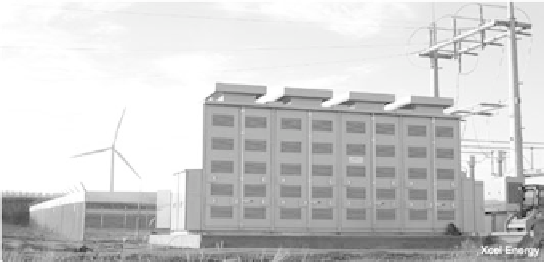Environmental Engineering Reference
In-Depth Information
One of the greatest characteristics of NaS batteries is its ability to provide power
in a single, continuous discharge or else in shorter larger pulses (up to fi ve times
higher than the continuous rating). It is also capable of pulsing in the middle of a
long-term discharge. This fl exibility makes it very advantageous for numerous
applications such as energy management and power quality. NaS batteries have
also been used for deferring transmission upgrades. Currently, NaS batteries cost
$810/kW, but it is only a recently commercialised product. This cost is likely to be
reduced as production increases, with some predicting reductions upwards of 33%
[3]. The major disadvantage of NaS batteries is retaining the device at elevated
temperatures above 270°C. It is not only energy consuming, but it also brings with
it problems such as thermal management and safety regulations [17]. Also, due to
harsh chemical environments, the insulators can be a problem as they slowly
become conducting and self-discharge the battery.
A 6 MW, 8 h unit has been built by
Tokyo Electric Power Company
(TEPCO)
and
NGK Insulators, Ltd
. (NGK), in Tokyo, Japan with an overall plant effi ciency
of 75% and is thus far proving to be a success (see Fig. 9). The materials required
to create a NaS battery are inexpensive and abundant, and 99% of the battery is
recyclable. The NaS battery has the potential to be used on a MW scale by com-
bining modules. Combining this with its functionality to mitigate power distur-
bances, NaS batteries could be a viable option for smoothing the output from wind
turbines into the power grid [3].
American Electric Power
is planning to incorpo-
rate a 6 MW NaS battery with a wind farm for a 2-year demonstration [18, 19].
The size of the wind farm has yet to be announced but the results from this will be
vital for the future of the NaS battery.
4.5 Flow battery energy storage
There are three primary types of FBES: vanadium redox (VR); polysulphide
bromide (PSB); zinc-bromine (ZnBr). They all operate in a similar fashion: two
charged electrolytes are pumped to the cell stack where a chemical reaction occurs,
allowing current to be obtained from the device when required. The operation of
each will be discussed in more detail during the analysis.
Figure 9: 6 MW, 8 h Sodium-sulphur energy storage facility in Tokyo, Japan [2].

Search WWH ::

Custom Search